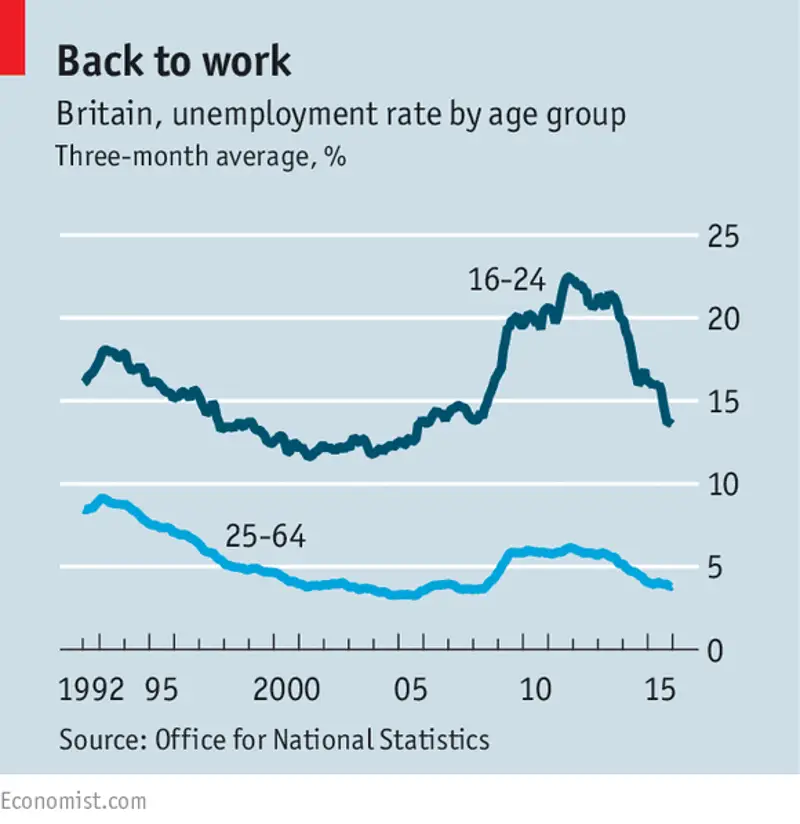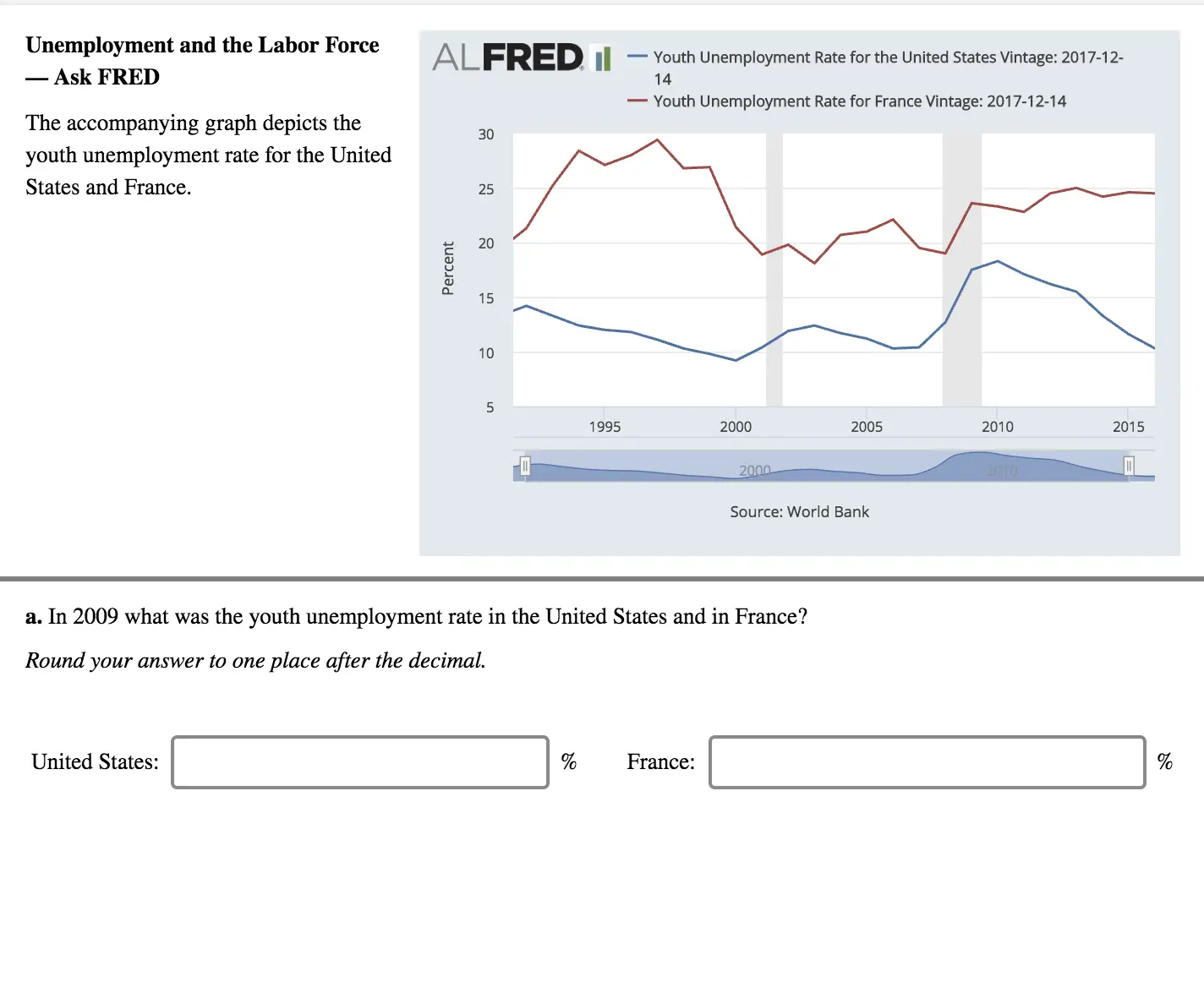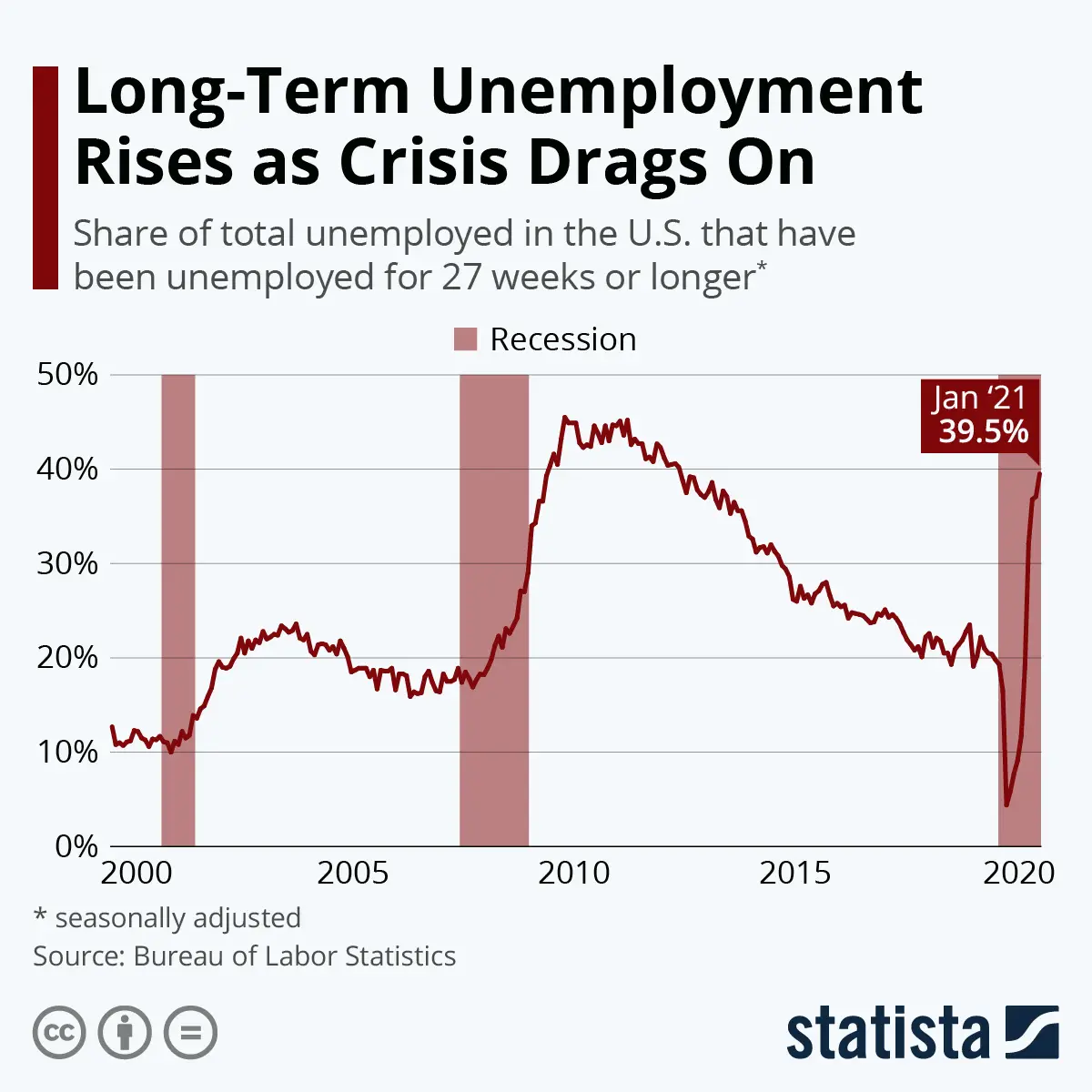From Education To Employment: The Skills Crisis
The quality and relevance of education is often considered as the first root cause of youth unemployment. In 2010, in 25 out of 27 developed countries, the highest unemployment rate was among people with primary education or less Yet, high education does not guarantee a decent job. For example, in Tunisia, 40% of university graduates are unemployed against 24% of non-graduates. This affects highly educated young females in particular. “In Turkey, the unemployment rate among university educated women is more than 3 times higher than that of university educated men in Iran and the United Arab Emirates, it is nearly 3 times and in Saudi Arabia, it is 8 times”.
Us Youth Unemployment Rate 1991
- U.S. youth unemployment rate for 2021 was 9.57%, a 5.28% decline from 2020.
- U.S. youth unemployment rate for 2020 was 14.85%, a 6.51% increase from 2019.
- U.S. youth unemployment rate for 2019 was 8.34%, a 0.24% decline from 2018.
- U.S. youth unemployment rate for 2018 was 8.58%, a 0.63% decline from 2017.
| U.S. Youth Unemployment Rate – Historical Data | ||
|---|---|---|
| Year | % of Total Labor Force Ages 15-24 | Annual Change |
The Role Of Labour Market Policy And Institutions
The role of labour market policy and institutions varies a lot from countries to countries. Here is a brief account of key propositions recently elaborated to facilitate access to employment for youth. First, a more balanced employment protection for permanent and temporary workers is needed. It will ensure that young people who lack work experience can prove their abilities and skills to then progressively transition to regular employment. It will also encourage a more equal treatment between permanent and temporary workers and help combat informal employment. This proposition has led to multiple discussions on flexible contracts to be designed and offered to youth. Second, discussions are focused on the level and spread of income support provided to unemployed youth. While some countries consider shifting their support from direct financial assistance to funding apprenticeship, others are increasing their support tying it back to stricter obligations of active search and training. Third, Governments are progressively involving employers and trainers to create a holistic approach to youth unemployment and provide intensive programmes with focus on remedial education, work experience and adult mentoring.
Read Also: How Do I File For My Unemployment
Us Youth Unemployment More Than Double Adult Rate During Pandemic
Economists believe that inequalities in youth employment have been worsened by the Covid-19 pandemic in the US.
As younger, Black, indigenous, and people of colour in the US face greater inequities than during past recessions, economists believe that inequalities in youth employment have been worsened by the Covid-19 pandemic.
Government As The Employer Of Last Resort

The government could also become the employer of last resort, just as central banks are the lenders of last resort. A job guarantee would maintain labor market stability and could establish full employment. This would introduce a shock absorber into the labor market. Full employment might also gain wider support among the electorate than a basic income policy.
Recommended Reading: Can You File Taxes If You Only Received Unemployment
Our Nation Has Renewed The American Dream Many Times Throughout Our History We Can Do It Again
Americas young adults cant be viewed through a single lens. They have unique histories and diverse talents, and some are facing significant challenges to reach their full potential despite their optimism and aspirations. They may be high school dropouts striving to get back on track, teen parents working to support their families, or current and former foster youth. Others have had periods of homelessness or been involved with the juvenile justice system, and some are finding it difficult to access, afford and complete a strong postsecondary education. Because of these differences, young adults must complete high school and have a variety of high-quality options including one-, two- and four-year degree programs that fit their ambitions and talents and equip them with comprehensive workplace skills.
The High Cost Of Youth Unemployment
The economic consequences of high youth unemployment are enduring, and failing to employ young people today will result in lost earnings, greater costs, and slower economic growth tomorrow.
Nearly everyone has struggled in the wake of the Great Recession, but young Americans have suffered the most. While others have slowly returned to work, the unemployment rate for Americans ages 1624 stands at 16.2 percent, more than double the national rate of unemployment. And even when this group eventually starts earning a paycheck, the impact of their unemployment will follow them for years. According to a new analysis by the Center for American Progress, young Americans will lose a staggering $20 billion in earnings over the next decade.
To be sure, getting our economy back on track will require getting people of all ages back to work. But the problem of youth unemployment is especially pernicious, and as such it deserves special attention from lawmakers.
In this issue brief we make the case that the United States has a serious youth-unemployment problem that will cost us dearly in the long run. We will show that the employment prospects for young Americans are dismal by both historical and international comparisons, and we will explore in detail the costs associated with our current levels of youth unemployment in terms of lost earnings, slower economic growth, and greater taxpayer burden.
Read Also: Can You Get Food Stamps If You Are Unemployed
Tvet And Vocational Education
The case has been made the past few years on the need to provide technical training to youth to prepare them specifically for a job. TVET and Vocational education would help address the skills crisis. Some countries among them Switzerland, The Netherlands, Singapore, Austria, Norway and Germany have been remarkably successful in developing vocational education and have reduced youth unemployment to as little as half the OECD average.
Three main reasons are usually presented for why vocational education should be a part of political programmes to combat youth unemployment:
Foundational skills have also been identified as key to a successful transition to work. “Across OECD countries, PISA results indicate that almost one in five students do not reach a basic minimum level of skills to function in today’s societies”. On average, 20% of young adults drop out before completing upper secondary education level. Vocational education aims at teaching foundational skills, as well as providing another option to general education pathways with practical job training.
Energy Policy And Carbon Price Certainty
Various studies place the cost of environmental regulations in the thousands of dollars per employee. Americans are split on whether protecting the environment or economic growth is a higher priority. Regulations that would add costs to petroleum and coal may slow the economy, although they would provide incentives for clean energy investment by addressing regulatory uncertainty regarding the price of carbon.
President Obama advocated a series of clean energy policies during June 2013. These included: Reducing carbon pollution from power plants Continue expanding usage of clean energy raising fuel economy standards and energy conservation through more energy-efficient homes and businesses.
Read Also: How Much Taxes Do They Take Out Of Unemployment
Unemployment As A Function Of The Business Cycle
To determine whether unemployment of young workers is caused by the business cycle, we examined the unemployment figures in 34 OECD countries in 20072009, years of economic crisis, and in 20092011, years of recovery and economic growth. For each country, we considered the data on unemployment among young workers and older adults and calculated the difference between 2009 and 2007 and between 2011 and 2009 for both groups. The data were taken from OECD publications and included information about the growth rates from 2007 to 2011. Our assessment of unemployment rates in 34 OECD countries reveals that the average rate of youth unemployment in 2007 was 13.4%, compared to 18.9% in 2011, so the delta of youth unemployment before and after the economic crisis was 5.55. The average rate of adult unemployment in 2007 was 4% compared to 5.8% in 2011, so the delta for adults was 1.88. Both of the differences are significantly different from zero, and the delta for young people is significantly larger than the delta for adults. These results indicate that among young people , the increase in unemployment due to the crisis was very large.
Table 4 Unemployment rate as a function of the business cycle
Spotlight On Us Youth
Labor Force Participation In February 2013, there were approximately 38.9 million youth in the U.S. with 21.4 million participating in the labor force, that is, either working or unemployed. In other words, 55.1% of the youth population was in the labor force, corresponding to what is known as the participation rate . Within youth, there remain large disparities in labor participation rates: teens defined as youth 16 to 19 years old had a participation rate of 34.7% while young adults 20 to 24 years old had a participation rate of 70.7% . Labor force participation across all youth was slightly higher for males than for females . Differences across races were much more pronounced .
EmploymentUnemployment
You May Like: How To Change Unemployment To Direct Deposit
President’s Council On Jobs And Competitiveness
President Obama established the President’s Council on Jobs and Competitiveness in 2009. The Council released an interim report with a series of recommendations in October 2011. The report included five major initiatives to increase employment while improving competitiveness:
Jobs Created By Presidential Term

Job creation is reported monthly and receives significant media attention, as a proxy for the overall health of the economy. Comparing job creation by President involves determining which starting and ending month to use, as recent Presidents typically begin in January, the fourth month into the last fiscal year budgeted by their predecessor. Journalist Glenn Kessler of The Washington Post explained in 2020 that economists debate which month to use as the base for counting job creation, between either January of the first term or February. The Washington Post uses the February jobs level as the starting point. For example, for President Obama, the computation takes the 145.815 million jobs of February 2017 and subtracts the 133.312 million jobs of February 2009 to arrive at a 12.503 million job creation figure. Using this method, the five Presidents with the most job gains were: Bill Clinton 22.745 Ronald Reagan 16.322 Barack Obama 12.503 Lyndon B. Johnson 12.338 and Jimmy Carter 10.117. Four of the top five were Democrats.
Writing in The New York Times, Steven Rattner compared job creation in the last 35 months under President Obama with the first 35 months of President Trump . President Obama added 227,000 jobs/month on average versus 191,000 jobs/month for Trump, nearly 20% more. The unemployment rate fell by 2 percentage points under Obama versus 1.2 points under Trump.
Recommended Reading: What Is The Black Unemployment Rate
Job Growth Projections 20162026
The U.S. Bureau of Labor Statistics reported on October 24, 2017 its projections of job growth by industry and job type over the 20162026 period. Healthcare was the industry expected to add the most jobs, driven by demand from an aging population. The top three occupations were: personal care aides with 754,000 jobs added or a 37% increase home health aids with 425,600 or 47% and software developers at 253,400 or 30.5%.
BLS also reported that: “About 9 out of 10 new jobs are projected to be added in the service-providing sector from 2016 to 2026, resulting in more than 10.5 million new jobs, or 0.8 percent annual growth. The goods-producing sector is expected to increase by 219,000 jobs, growing at a rate of 0.1 percent per year over the projections decade.” BLS predicted that manufacturing jobs would decline by over 700,000 over that period.
Effect Of Disability Recipients On Labor Force Participation Measures
The number of people receiving Social Security disability benefits increased from 7.1 million in December 2007 to 8.7 million in April 2012, a 22% increase. Recipients are excluded from the labor force. Economists at JPMorgan Chase & Co. and Morgan Stanley estimated this explained as much as 0.5 of the 2.0 percentage point decline in the U.S. labor-force participation rate during the period.
You May Like: How Do I Sign Up For Unemployment In Maine
Effects Of Healthcare Reform
CBO estimated in December 2015 that the Patient Protection and Affordable Care Act would reduce the labor supply by approximately 2 million full-time worker equivalents by 2025, relative to a baseline without the law. This is driven by the law’s health insurance coverage expansions plus taxes and penalties. With access to individual marketplaces, fewer persons are dependent on health insurance offered by employers.
Oecd Countries During The Post 2008 Crisis
The recent global economic crisis took an outsized toll on young workers across the globe, especially in advanced economies, which were hit harder and recovered more slowly than emerging markets and developing economies. Does this fact imply that the labor market in Spain and Portugal is less friendly toward younger individuals than the labor market in Israel and Germany ? Has the market in Spain and Portugal become less friendly toward young people during the last 4 years? We argue that the main factor causing the increasing youth unemployment rates in Spain and Portugal is the poor state of the economy in the last 4 years in these countries rather than a change in attitudes toward hiring young people.
OECD data indicate that adult unemployment is significantly lower than youth unemployment. The global economic crisis has hit young people very hard. In 2010, there were nearly 15 million unemployed youngsters in the OECD area, about four million more than at the end of 2007 .
Recommended Reading: What Is The Unemployment Percentage In The United States
Comparison Of Employment Recovery Across Recessions And Financial Crises
One method of analyzing the impact of recessions on employment is to measure the period of time it takes to return to the pre-recession employment peak. By this measure, the 20082009 recession was considerably worse than the five other U.S. recessions from 1970 to present. By May 2013, U.S. employment had reached 98% of its pre-recession peak after approximately 60 months. Employment recovery following a combined recession and financial crisis tends to be much longer than a typical recession. For example, it took Norway 8.5 years to return to its pre-recession peak employment after its 1987 financial crisis and it took Sweden 17.8 years after its 1991 financial crisis. The U.S. is recovering considerably faster than either of these countries.
Effects Of Minimum Wages
Economic research indicates that minimum wages increases youth unemployment in competitive labour markets for unskilled youth labour, and that the resulting delayed entry into the job market leads to a reduction in training opportunities and thus a reduction in lifetime income. However, research also indicates that “imposing a minimum wage may increase the income of working youths if their hours of work are not reduced in response to the minimum wage” and “minimum wages may increase the aggregate income of youths if the gains for those who work exceed the losses for those who cannot find work.” As a policy measure to support young unskilled workers, economist Charlene Marie Kalenkoski suggests that “instead of a minimum wage, policymakers should use less distortionary means to support young unskilled workers, such as cash or in-kind assistance.”
Don’t Miss: How To Apply For Unemployment In Sc
Unemployment And Social Unrest
- Social unrest is more common in countries and regions where male youth unemployment is high or rising rapidly.
- The private sector is the main driver in the fight against poverty, providing 9 in 10 jobs.
- Youth unemployment situation is common to all regions and is occurring despite improvements in average educational attainment of youth cohorts, thereby fueling social discontent.
- An estimated 400 million youth worldwide or about 1/3 of all youth aged 15 to 24 suffer from a deficit of decent work opportunities.
- About 152 million young workers live in households that are below the poverty line , comprising 24 percent of all working poor.
- Whether youth are enrolled in school, work, are receiving training, or underemployed or unemployed has important implications for future economic growth and development and stability.
Young Persons’ Participation In The Labour Force

As explained above, the unemployment rate and unemployment ratio differ because the unemployment rate includes in the denominator only the part of the population that is in the labour force. There is also a strong link between labour force participation and educational status, which becomes particularly clear when looking at young people’s situation at different ages. This section analyses this issue in detail.
At 15 years of age, nearly 100 % of the population in the EU and its Member States are still at school. As the young grow older, many move into the labour force, becoming employed or unemployed, or remain outside the labour force. Not all young people make this transition at the same age, so there is a gradual rise in the number of young people in the labour force.
Figure 4 is based on EU-LFS data and it counts all those who state they have been in formal education or training during the previous four weeks. It does not include people who exclusively participated in non-formal training sessions such as attending a course, a seminar or taking private lessons.
Also Check: How To Sign Up For Unemployment Illinois
